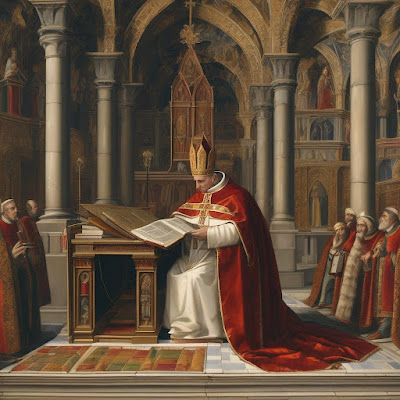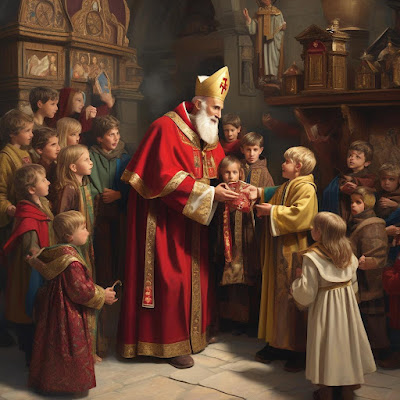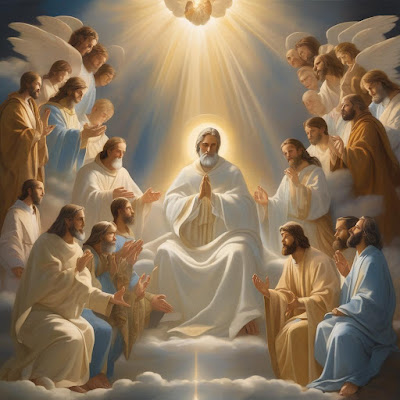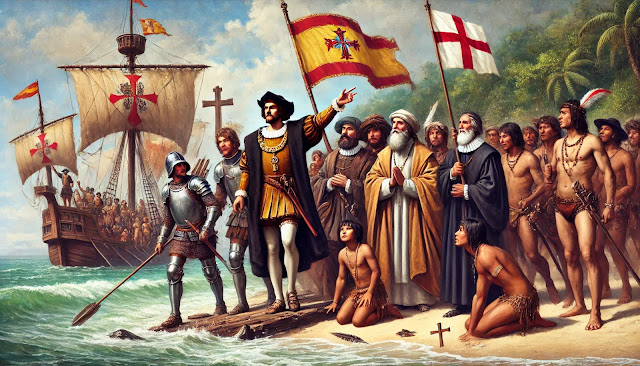The veneration and intercession of saints have never troubled me. Scripture clearly states that we will “partake of the divine nature” (2 Peter 1:4)—meaning that, in Heaven, we will be like God. In Catholicism, this process is called “sanctification,” and in Eastern Orthodoxy, it’s known as “theosis.” While we won’t become God Himself—an impossibility for created beings—we will share in His attributes, knowledge, and glory (cf. 1 John 3:2; 1 Corinthians 13:12). Christ Himself affirmed that His followers would perform great miracles through Him (John 14:12), which supports the Catholic understanding of saints’ intercessory powers.
I also believe that the pagans, in their own way, received a shadow of divine revelation about the truth of Christianity, including the future role of the saints. However, they misunderstood and distorted this revelation, turning saints into polytheistic gods, goddesses, and demigods. Since all religions contain some measure of truth and goodness—misinterpreted reflections of God’s revelation—it makes sense to me that the one true faith, the Catholic Church, would embody these truths while rejecting the errors. This conviction is yet another reason I’m Catholic.
Nevertheless, critics claim that Catholic saints are simply renamed pagan gods, that the Church compromised the Gospel and adopted a form of polytheism by replacing pagan deities with so-called "saints" to appeal to pagans. But is this accusation really true? Let’s examine this more closely.
Are Catholic Saints Renamed Pagan Gods? Separating Fact from Fiction
The question of whether Catholic saints are merely “renamed” pagan gods is a longstanding accusation that has been directed at the Church for centuries. Critics argue that the Church, in its efforts to convert pagan populations, simply replaced their deities with Christian saints to facilitate the process. But is this claim accurate, or is it a misunderstanding of the Church’s teachings and historical practices? A careful examination of scripture, Church documents, and scholarly opinions provides clarity.
Understanding the Role of Saints in Catholicism
The veneration of saints in Catholicism is rooted in the belief that they are holy individuals who, by God’s grace, exemplify Christian virtues and intercede on behalf of the faithful. The Church does not worship saints as gods, as made clear in the Catechism of the Catholic Church: “The Church venerates the saints and asks for their intercession, but worship and adoration are due to God alone” (CCC 971). Saints are seen as models of faith and conduits to Christ, not deities in themselves.
This distinction is further emphasized by Church Fathers such as St. Augustine, who in his City of God rejected any suggestion that the saints are equivalent to pagan gods. He argued that while pagans worshiped their gods as entities with powers independent of God, Christians view saints as completely dependent on and subordinate to God’s will (cf. City of God, Book VIII).
The Church’s Position: No Syncretism Allowed
The Church has always been cautious about accusations of syncretism (the blending of different religious beliefs). The Council of Nicaea (AD 325) and the Council of Trent (1545-1563) both clarified the role and veneration of saints to ensure it aligned with Christian doctrine. The Second Vatican Council reaffirmed this, stating: “The veneration of the saints is to be distinguished from the worship which is due to God alone” (Lumen Gentium, 51).
In the fourth century, Pope Gregory the Great clarified the Church’s stance when writing to St. Mellitus, a missionary in Britain. He instructed not to destroy pagan temples but to purify them for Christian use and to encourage the celebration of Christian feast days, so that the people would “celebrate these, instead of the pagan feasts.” However, he was clear that pagan practices and beliefs were to be eradicated, not assimilated (cf. Letter to Abbot Mellitus, 601 AD).
Addressing the Misconception: Origins of the Critique
The misconception that Catholic saints are merely renamed pagan gods likely arises from a superficial similarity between certain saints and pagan figures. For instance, St. Brigid of Ireland is often said to have replaced the Celtic goddess Brigid. However, historical evidence indicates that St. Brigid was a real Christian woman who established monasteries and was known for her charity. The Church did not create or rename her to replace a deity, but rather elevated her to sainthood for her devout Christian life.
This critique is also commonly aimed at the celebration of feast days, which some claim were adapted from pagan festivals. For example, Christmas and All Saints’ Day are said to have replaced pagan solstice celebrations. But as historian Ronald Hutton notes, the selection of these dates was more complex and based on theological considerations, not a deliberate co-opting of pagan holidays (Stations of the Sun: A History of the Ritual Year in Britain, 1996).
Another example of a saint often mistaken for a pagan deity is St. Nicholas, commonly associated with the Greek god Poseidon or the Roman god Neptune. This confusion arises from his connection to sailors and the sea.
St. Nicholas vs. Poseidon/Neptune
St. Nicholas, a 4th-century bishop of Myra (in modern-day Turkey), is widely known as the patron saint of sailors. Many legends about St. Nicholas involve his miraculous interventions at sea, such as calming storms and saving sailors from shipwreck. This has led some to draw parallels between St. Nicholas and Poseidon/Neptune, who were revered by ancient Greeks and Romans as gods of the sea.
However, the association of St. Nicholas with the sea has a distinctly Christian origin. Historical records show that St. Nicholas’s protection of sailors was not an attempt to replace or Christianize Poseidon, but rather a reflection of the bishop’s intercessory power and the deep faith of seafaring Christians. His legends emphasize God’s power and mercy, not pagan deities.
According to the Catholic Encyclopedia, the cult of St. Nicholas spread rapidly in both the East and West, and by the 6th century, he was already being honored as a miracle worker. The Byzantine Emperor Justinian I even built a church in his honor, recognizing him as a saint whose life and deeds exemplified Christian virtues, completely separate from any pagan association (Catholic Encyclopedia, "St. Nicholas of Myra").
Moreover, the Catechism of the Catholic Church distinguishes clearly between the veneration of saints and any form of worship that could be attributed to pagan gods. St. Nicholas is celebrated for his generosity, protection, and compassion, qualities that set him apart from the more capricious nature of mythological gods like Poseidon. The celebration of his feast day on December 6th eventually led to the development of various Christmas traditions, but his status as a saint was rooted in historical fact and Christian devotion, not a repurposing of pagan mythology.
Thus, while St. Nicholas’s connection to sailors may superficially resemble that of Poseidon/Neptune, he was not a replacement for these deities but rather a Christian saint whose life inspired devotion among the faithful, especially those who relied on the sea for their livelihood.
St. Martin of Tours and His Association with Pagan Gods
St. Martin of Tours is another example of a Christian saint who has been mistakenly identified with a pagan god. A 4th-century bishop and former Roman soldier, St. Martin is celebrated as the patron saint of soldiers and is known for his acts of charity and humility. His feast day, November 11th, falls around the time of many pre-Christian autumnal festivals, leading some to speculate that his veneration is merely a continuation of older pagan practices.
St. Martin and the God Mars
One of the most common claims is that St. Martin replaced the Roman god Mars, the god of war. This association arises from the similarity of their names—Martin derives from "Martinus," which in turn is related to Mars—and the fact that St. Martin is considered the patron saint of soldiers. Some critics suggest that early Christians co-opted the worship of Mars, transforming the war god into a Christian saint who represented virtues appropriate to soldiers, such as courage, charity, and humility.
However, this theory does not hold up under scrutiny. Historically, St. Martin’s veneration has always been centered around his life story, particularly his act of charity in cutting his cloak in half to share it with a beggar, who was later revealed to be Christ Himself. This episode emphasizes mercy and selflessness rather than the martial valor typically associated with Mars. The Catechism of the Catholic Church (CCC 2633) highlights intercession for others as a key Christian virtue, which was embodied in St. Martin’s life, making him a suitable model for Christians, especially soldiers, who were called to follow Christ’s example of peace and compassion.
St. Martin and Pagan Festivals
St. Martin’s feast day, falling on November 11th, coincides with the timing of pagan harvest festivals in Europe, such as the Germanic celebration of Martinalia and the Celtic festival of Samhain. These festivals marked the end of the agricultural season and the beginning of winter. As the Church sought to evangelize pagan communities, it is likely that St. Martin’s feast day was used as a Christian alternative to these pre-Christian observances. However, this does not mean that St. Martin himself was a transformed pagan figure.
Pope Benedict XVI, in his General Audience on July 4, 2007, described St. Martin as “one of the most famous and revered saints in Europe, as well as a great missionary.” He emphasized that St. Martin’s influence and popularity stemmed not from any association with pagan gods but from his dedication to spreading Christianity and caring for the poor.
Historical Misinterpretation
The mistaken association of St. Martin with Mars or other pagan gods is often the result of superficial similarities in name or the proximity of his feast day to pre-existing pagan festivals. As historian Ronald Hutton explains in Stations of the Sun: A History of the Ritual Year in Britain, the Church’s decision to place Christian feast days near pagan festivals was not an attempt to "rename" pagan gods, but rather a strategy to provide the faithful with opportunities to celebrate Christian mysteries in familiar seasonal contexts.
Moreover, the Second Vatican Council's document Lumen Gentium clarifies that the purpose of venerating saints is to honor the work of Christ in their lives, not to continue or replicate pagan customs (cf. LG 50). The Council reiterates that the saints are honored not as deities, but as friends and servants of God, completely distinct from pagan worship.
In summary, while St. Martin’s feast day and some aspects of his veneration might have been positioned to align with the calendar of pagan festivals, his identity and legacy are firmly rooted in Christian theology and practice. St. Martin is celebrated not as a rebranded pagan god, but as a genuine Christian saint whose life and deeds exemplify the virtues of faith, charity, and humility.
Saint Mary vs. Artemis/Diana
Yet another example Catholic detractors love to use is the Catholic view of Saint Mary, claiming she was just the goddess Artemis and Diana renamed. However, Saint Mary is not a renamed version of the pagan goddess Artemis (or Diana). This claim, often made in certain historical theories or anti-Catholic arguments, lacks substantial evidence and oversimplifies the complexities of religious history and theology. Here’s why:
Distinct Origins and Theologies:
The Virgin Mary and the goddess Artemis (known as Diana in Roman mythology) originate from vastly different religious traditions and have distinct roles and attributes. Artemis was the Greek goddess of the hunt, wilderness, and childbirth, and was often associated with nature and fertility. On the other hand, Mary is a central figure in Christianity, revered as the mother of Jesus Christ. Her veneration is rooted in Christian beliefs about her role in salvation history, not in pagan mythology.
Differences in Attributes and Worship:
Artemis was worshiped as a virgin goddess and protector of young women, but her cult and iconography emphasized independence and nature. In contrast, Mary’s veneration focuses on her purity, humility, and her role as the Mother of God. While both are associated with virginity, the significance of this attribute is entirely different. Additionally, Artemis was worshiped with rituals and offerings specific to her domains, whereas Marian devotion in Christianity involves prayers, intercessions, and feast days related to events in Mary’s life.
Historical Development of Marian Devotion:
Marian devotion developed organically within the context of early Christianity. By the time devotion to Mary grew in prominence (around the 3rd and 4th centuries), Christianity had already established its distinct theological identity, separating itself from pagan practices. While it is true that some aspects of Marian devotion may have been influenced by the broader cultural context (e.g., art styles or terminology), this does not mean Mary was merely a rebranded pagan goddess. Theological reflection on Mary’s role began with early Christian writers like the Church Fathers, who emphasized her unique role in the Incarnation and redemption.
Ephesus and the Connection to Artemis:
The claim often arises from the fact that the Council of Ephesus in 431 AD, which proclaimed Mary as “Theotokos” (Mother of God), was held in a city historically associated with the cult of Artemis. However, this does not imply that Mary is a continuation of Artemis worship. Ephesus was an important center for early Christianity, and the council’s decisions were based on Christological debates, not an attempt to syncretize with the local cult. By that time, Ephesus had long been a Christian city, and any similarities in language or symbolism are more likely due to cultural adaptation rather than religious continuity.
Syncretism and Misunderstanding:
While some scholars have noted that early Christianity occasionally adopted certain symbols or terms familiar to converts from other religions (a process known as inculturation), this was done to communicate Christian truths more effectively, not to merge with or continue pagan worship. The distinct doctrines, teachings, and liturgical practices of Marian devotion show no substantial theological overlap with the worship of Artemis or Diana.
In conclusion, while there may be superficial similarities in iconography or terms due to cultural factors, the theological foundations, historical origins, and religious meanings behind the veneration of Mary and the worship of Artemis/Diana are fundamentally different.
The Protestant Perspective
Many Protestant reformers in the 16th century, such as Martin Luther, criticized the veneration of saints as being too similar to the worship of pagan gods. Luther argued that the intercession of saints detracted from Christ’s role as the sole mediator (cf. Luther’s Works, vol. 25). John Calvin took a similar position, accusing the Catholic Church of encouraging “a mere transference of the worship of idols” (Institutes of the Christian Religion, Book I, Ch. 12).
However, contemporary Protestant scholars like Jaroslav Pelikan recognize that while Catholic practice has a “visual and symbolic” aspect that can seem reminiscent of pagan imagery, it is fundamentally rooted in Christian theology and Christocentric spirituality (Mary Through the Centuries, 1996).
The Church’s Response to the Accusation
The Church has always maintained that any superficial resemblance to pagan practices is coincidental and that the sanctification of elements from local cultures, such as architecture or art, is not an endorsement of pagan beliefs. As Pope Benedict XVI stated, “The Church has always taken the best of pagan culture… but she purifies it and transforms it to conform with the Gospel” (The Spirit of the Liturgy, 2000).
Moreover, the Church has officially denounced any attempt to syncretize Christian beliefs with paganism. The Council of Trent explicitly condemned any practice that would imply the worship of saints as deities (Session XXV, Decree on the Invocation, Veneration, and Relics of Saints).
A Balanced Perspective: Why This Argument Persists
Despite clear teachings and historical evidence to the contrary, the idea that Catholic saints are renamed pagan gods persists because of the complex history of the Church’s interaction with diverse cultures. When Christianity spread, it often built churches over former pagan sites and reinterpreted local symbols in light of Christian theology. This led to a perception of continuity where there was actually a deliberate transformation and redefinition.
The Catholic Church’s position is clear: saints are not worshiped as gods, nor were they adopted to replace pagan deities. Instead, the Church seeks to honor holy individuals who exemplified Christian virtues and to present them as models for the faithful. While pagan religions may contain some elements of truth, these truths are perfected in Christ and His Church.



















.JPG)
.JPG)




.jpg)




.jpg)












.jpg)

.jpg)